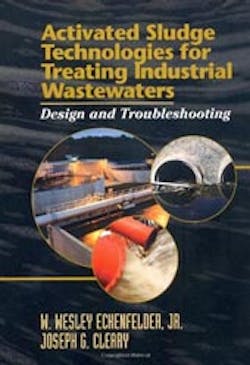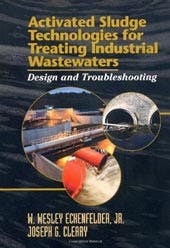Recommended Reading: New Book Examines Activated Sludge Technologies for Treating Industrial Wastewaters
The activated sludge process for treating municipal and industrial wastewater dates back more than 100 years. The first experiments on aerated wastewater and cultured organisms were conducted by Clark and Gage in 1912 and 1913. The first formal presentation, involving production of an activated mass of microorganisms to aerobically stabilize organic matter in wastewater using air or oxygen, was also shared on April 3, 1914.
Accordingly, a new book, Activated Sludge Technologies for Treating Industrial Wastewaters: Design and Troubleshooting, has been published to provide critical information on the applications of activated sludge for treating industrial wastewaters, as well as other effluents that impact publicly- owned treatment works (POTWs). Articulating the motivation and timing for writing the book, the authors emphasized the 100th birthday of activated sludge as well as the need to convey important data from their many workshops.
Trends and Technologies Outlined
Although the fundamentals of the activated sludge process have essentially remained unchanged over the last 100 years, there have been significant fluctuations in technology, operating experience and effluent permit limits and energy saving drivers. Likewise, technological advances include membrane bioreactors, nitrogen and phosphorus nutrient processes, treatability testing, and process modeling tools to design and troubleshoot performance of activated sludge treatment technologies.
The authors have presented this subject matter at numerous workshops and the Manhattan College Institute for Water Pollution Control, and decided it was time to summarize developments and trends over the last 20 years for engineers, operators and students with a focus on industrial wastewater. One of the chapters in the book reviews basic principles of the activated sludge process.
Regulatory drivers have evolved over the years, from BOD and TSS removal for secondary treatment to nitrogen and phosphorus removal for advanced or tertiary treatment. Recent changes have included more stringent metals and nutrient limits to remove specific organics for the chemical and pharmaceutical industries. More recent trends in the U.S. and Europe include the need to remove microconstituents such as pharmaceuticals and personal care products. Some of this, however, is not driven by regulations but by corporate industry standards and sustainability goals.
The basic activated sludge process has evolved over the years through a variety of configurations, such as plug flow and fully-mixed systems, and sequencing batch reactors (SBR). Advancements range from adding media for biomass to attach to in moving bed bioreactors to membranes, which replace final clarifiers for solids-liquid separation from the treated wastewater in membrane bioreactors. Anaerobic treatment is also used for high-strength wastewaters to recover energy and reduce biosolids production, treatment and disposal costs. Further, nitrogen and phosphorus removal technologies have advanced in the last decade to include a variety of new processes that select specific microorganisms to use throughout the treatment processes. One chapter in the book reviews many of the advancements in these technologies over the years, and a number of case studies are presented, illustrating design calculations.
Nitrogen removal fundamentals as well as design and troubleshooting case studies are covered in detail. These case studies depict how a project progresses from treatability testing to design, start-up, and even troubleshooting and re-start due to loss of nitrification. The use of process modeling tools for design and troubleshooting are presented with easy-to-follow design calculations.
The continued focus on the removal of specific organic chemicals and pharmaceuticals in wastewater still relies on the activated sludge process for the majority of removal by biodegradation and adsorption to the biomass. Polishing treatment is now used to remove specific organics in order to lower concentrations and effluent toxicity or estrogenicity using chemical oxidation, carbon adsorption and other technologies. A whole chapter is devoted to the removal of microconstituents and includes case studies where activated sludge is primarily used along with membranes and ozone for final destruction of pharmaceutical actives.
Treatability testing at laboratory and pilot scales, in conjunction with process modeling, is commonly used today for design and troubleshooting. Testing protocols have been developed to determine the fate of the specific organics and nutrients through a variety of activated sludge systems. Further, the process modeling tools available are also used for design, performance optimization and troubleshooting. One chapter is devoted to the various types of treatability tests available with real examples of how the design information is developed and used for full-scale design of an SBR treatment plant.
One of the biggest technological advancements affecting industrial wastewater in recent years has been the ability to extract natural gas from shale. Shale gas production uses large amounts of water, which impacts discharges to activated sludge plants. Shale gas is only one example of the need for smart wastewater management, mostly using physical/chemical treatment processes rather than activated sludge. To prepare that chapter, the authors consulted colleague John Schubert of HDR, an expert on shale gas water management.
Another key trend is the treatment of activated sludge plant effluent through a variety of technologies to achieve the quality of water needed for reuse/recycling in industrial utilities such as cooling towers and boiler systems. The addition of multimedia filtration, membrane or ultrafiltration and reverse osmosis is also discussed for achieving drinking water quality for reuse in industrial plants.
Rainwater-harvesting case studies are also presented. These types of projects are being driven by companies' sustainability goals to reduce their water and energy footprints. One chapter is devoted to examples of treating activated sludge effluent using tertiary treatment technologies to achieve the water quality needed to recycle the water to cooling towers, boilers and other utilities in the pharmaceutical, food and beverage and other industries.
In summary, this book provides a comprehensive overview and wealth of current information for engineers, operators and students working on industrial water and wastewater projects.
For more information on the publication or to order, visit: http://www.destechpub.com/links/catalogs/bookstore/environmental-technology-2/activated-sludge-technologies-for-treating-industrial-wastewaters/.
Book Reviews
"Here in one compact volume, we have an up-to-date handbook for the practicing engineer covering nearly a century of learning from industrial wastewater experience in the United States, as well as a survey of newer technologies including some useful developments from Europe. For the graduating student or younger engineer, the voice of the late Wes Eckenfelder will guide and enable you to benefit from his five decades of experience, and Joe Cleary will bring you right up to speed on today's issues and technologies. Highly recommended."
-- Ed Helmig, Practicing Wastewater Engineer
"A wealth of information lies within this compact manual for the target audience of operators, engineers and students. There are many helpful charts and tables of values (e.g. biokinetic rate coefficients for various types of organic-bearing wastewaters, trace nutrient requirements for activated sludge). Concepts are reinforced by liberal use of well- documented design procedures and examples. In situations where more than one type of activated sludge process might be applied, the authors provide helpful lists of question to ask when deciding between process options. The relevance of the manual to the present is exemplified by the inclusion of current topics of interest such as shale gas wastewater treatment, removal of microconstituents, and water recycling and reuse within industries."
-- Hugh Monteith, Senior Consultant, Hydromantis Environmental Software Solutions

